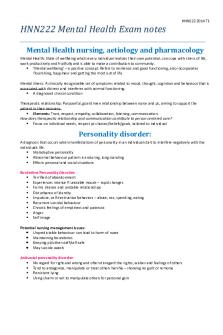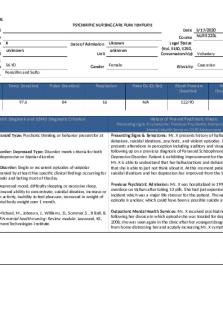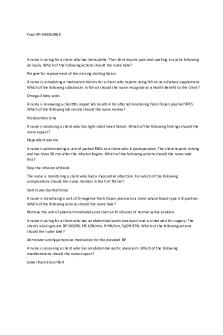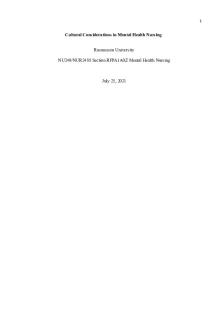Summary - complete - Mental health nursing PDF

| Title | Summary - complete - Mental health nursing |
|---|---|
| Course | Mental Health Nursing |
| Institution | Deakin University |
| Pages | 19 |
| File Size | 509.2 KB |
| File Type | |
| Total Downloads | 114 |
| Total Views | 435 |
Summary
2014 T1 Mental Health Exam notes Mental Health nursing, aetiology and pharmacology Mental Health: State of wellbeing which every individual realizes their own potential, can cope with stress of life, work productively and fruitfully and is able to make a contribution to community. a positive concept...
Description
HNN222 2014 T1
HNN222 Mental Health Exam notes Mental Health nursing, aetiology and pharmacology Mental Health: State of wellbeing which every individual realizes their own potential, can cope with stress of life, work productively and fruitfully and is able to make a contribution to community. ‘Mental wellbeing’ – a positive concept. Refers to resilience and good functioning, also incorporates flourishing, happiness and getting the most out of life Mental illness: A clinically recognizable set of symptoms related to mood, thought, cognition and behaviour that is associated with distress and interferes with normal functioning. A diagnosed clinical condition Therapeutic relationship: Purposeful, goal driven relationship between nurse and pt, aiming to support the patient in their recovery. Elements: Trust, respect, empathy, collaboration, listening, communication. How does therapeutic relationship and communication contribute to person centered care? Focus on individual needs, respect pt choices/beliefs/goals, tailored to individual
Personality disorder: A diagnosis that occurs when manifestations of personality in an individual start to interfere negatively with the individuals life. Maladaptive personality Abnormal behaviour pattern is enduring, long standing Effects personal and social situations Borderline Personality Disorder: Terrified of abandonment Experiences intense + unstable moods – rapid changes Forms intense and unstable relationships Disturbance of identity Impulsive, self destructive behaviors – abuse, sex, spending, eating Recurrent suicidal behaviour Chronic feelings of emptiness and paranoia Anger Self image Potential nursing management issues: Unpredictable behaviour- can lead to harm of nurse Maintaining boundaries Keeping pt/other staff/self safe May suicide watch Antisocial personality disorder: No regard for right and wrong and often disregard the rights, wishes and feelings of others Tend to antagonize, manipulate or treat others harshly – showing no guilt or remorse Persistent lying Using charm or wit to manipulate others for personal gain
HNN222 2014 T1 Aetiology of mental illness: Biological, psychological, environmental Biological aetiological theories for mental illness: Genetics = increased predisposition Biochemistry – neurotransmitter theory Brain structure abnormalities Endocrine system dysfunction (thyroid)
Psychotropic medications: Psychotropic: psychiatric medicines that alter chemical levels of the brain = impact mood + behaviour Antipsychotics, antidepressants, mood stabilizers, ADHD drugs, anti anxiety NEUROTRANSMITTERS: Dopamine: Related to psychosis (schizophrenia) Serotonin: Mood disorders (Depression)
Antidepressants
SSRI (selective serotonin reuptake inhibitors) Atypical Tricyclic (TCA) MAOIs (Monoamine oxidase inhibitors)
SSRI’s Increase serotonin by inhibiting its reuptake into pre-synaptic cell, increasing levels of serotonin in the synaptic cleft available to bind to postsynaptic receptor. Block the uptake of serotonin back into brain cells = increase amount of serotonin available in the brain for transmitting signals. This increase in improves symptoms of depression Examples: Citalopram Fluoxetine (Prozac) Sertaline (Zoloft) Side effects: Nausea Insomnia Dizziness Weight loss/gain Anxiety + restlessness Decreased sex drive Dry mouth Fatigue Atypical: Reuptake inhibitors Include serotonin and norepinephrine reuptake inhibitors (SNRIs, NDRIs, NRIs) Alter chemical messages (neurotransmitters) used to communicate between cells Examples: Bupropion, Mirtazapine Side effects: Fatigue
HNN222 2014 T1
Weight gain Nausea Headache Insomnia Blurred vision
Tricyclic: Inhibit the reuptake (absorption) of serotonin or norepinephrine (=more available in brain). Helping brain cells send and receive messages= boosts mood. More side effects than other antiD’s Mostly been replaced due to side effects Examples: Desipramine (Norpramin) Doxepin Side effects: Dry mouth Blurred vision Constipation Urinary retention Drowsiness Increased appetite = weight gain Decreased sex drive MAOIs Inhibits the activity of monoamine oxidase (enzyme)=preventing the breakdown of monomine neurotransmitters and increase the availability in synaptic cleft Reduces the breakdown of neurotransmitters norepinephrine, serotonin and dopamine = improve brain cell communication First type of antiD invented, mostly been replaced due to MAOIs side effects Typically requires diet restrictions Can be used to treat other conditions e.g. Parkinsons Examples: Phenelzine (nardil) Selegiline (Emsam) Side effects: Dizziness or lightheadedness Insomnia Weight gain Headaches Sexual problems Nausea Diarrhea or constipation
Antipsychotics (neuroleptic) Used to treat: Psychosis, schizophrenia, mania Typical: 1st generation Act on dopamine levels (dopamine antagonists) – block dopamine receptors Reduce positive symptoms of schizophrenia Atypical: 2nd generation (newer)
HNN222 2014 T1
Act on dopamine and serotonin levels – block Reduce positive and negative schizophrenic symptoms Without the EPSE’s (extrapyramidal side effects) – effect the extrapyramidal motor system (same system responsible for the movement disorders of Parkinson’s – can give antiparkinsonian meds to counteract the epse’s
Typical Examples: Chlorpromazine (Largactil) Halaperidol Side effects: Effects on CNS (EPSE’s: o Acute dystonic reaction (painful muscle spasms in head, back and torso) o Seizures o Akathisia: restlessness, leg aches, person cannot stay still o Tardive dyskinesia – uncontrolled movement of persons mouth, tongue Other: o Dry mouth, blurred vision, urinary retention o Weight gain, diminished libido o Sedation
Atypical Quetiapine (seroquel) Rispiridone Olanzapine Clozapine (last resort) Weight gain – main one Constipation Dizziness Insomnia Headache Drowsiness Dry mouth
Clozapine: Regulations around it Treatment of schizophrenia in pts as a last resort Atypical Blocks dopamine receptors in brain = preventing excess activity of dopamine Side effects: o Drowsiness o Increased HR, Salivation o Headache, tremor o Fever
Antianxioytics – anti anxiety Anxiety disorders – involve neurotransmitters serotonin, noradrenalin and dopamine Benzodiazepines and non-benzodiazepines Benzodiazepines: Commonly prescribed for short term relief of severe anxiety. Can assist with sleep Inhibit neurotransmitter GABA Depressant drug – slow down activity on CNS and messages travelling between brain and body Used a lot for prn meds High withdrawal symptoms Side effect Nursing intervention Drowsiness – lack of energy Encourage appropriate activity but warn against those such as driving Dizziness/lightheadedness Observe and take steps to prevent falls Feeling detached Encourage socialization Dependency Encourage short term use, educate to avoid other drugs e.g. alcohol Slurred speech
HNN222 2014 T1
Depression Memory loss/ forgetfulness Nausea Blurred vision
Examples: (most things ending in PAM) Diazepam (Valium) Alprazopam –( Xanax)
Biopsychosocial model: Biological, psychological and social factors contributing to mental health and illness. Biological: Physical health Medications Alcohol/drug use Sexual health Genetics Disability Psychological: Thoughts Coping skills Mental status Self concept/esteem Social: Occupation School/work Family/friends Social isolation/connection Cultural CASE STUDY: Read the following and develop and brief care plan based on the principles of the Biopsychosocial framework Jenni is a 23 year old woman who arrived at ED with a friend after falling over and sustaining a deep laceration to her arm. On arrival she appeared to be intoxicated, distressed and tearful. On examination she admitted to use ketamine and alcohol at a club, but added she does not usually use drugs, but the past month she has been ‘out of control’ since breaking up with her BF. She describes feeling depressed, unable to work, poor appetite and sleep for the past 2 weeks. BIO: Medication, harm minimization, referral drug/alcohol service Psycho: Support, reassurance, mental health assessment, counseling Social: referral to social support, employment assistance, youth mental health services
Recovery:
Not about absence of illness – about managing symptoms and living with them Individual journey + goals Family/carer involvement
HNN222 2014 T1
Legality of mental health: Mental health act: Only in public system (takes voluntary and involuntary) AIMS: Provides care, treatment and protection of mentally ill people who do no consent to treatment Facilitate the provision of treatment + care Protects the pts rights Ensure the best possible treatment in the least restrictive environment Section 8 criteria: 1. Appears mentally ill 2. At risk to self or others 3. Requires immediate treatment 4. Unable or refuses consent to treatment 5. Treatment in the least restrictive environment (a hospital) MUST fit all criteria Section 9 criteria ( request and recommendation) Anyone over 18 can make a request for someone to see a psychiatrist Must be recommended by a psychiatrist Section 18: pts rights Dignity, respect, visitors, 2nd opinion Seclusion: Small white room Little/ no stimuli (mattress, sheets, pillow) When an individual is at risk to themselves or others Restraint: Risk of harming self/ others Medications (depot) Risk of damaging property Seclusion + restraint: Must have good rational to why restraining – nurse can do it Let psychiatrist know why Whilst restrained :visual obs every 15 mins, reviewed every 4hrs by medical officer to make sure they are physically able to be restrained CTO – community treatment order: Order requiring person to obtain treatment for mental illness while not detained in a mental health facility Must specify the duration of order May specify where the person must live A psychiatrist can make a CTO for a person who is subject to an ITO if they are satisfied that: o Criteria for section 8 apply (criteria for involuntary treatment) o The treatment required can be obtained through a CTO Strengths and weakness of ITO:
HNN222 2014 T1 Strengths Prevent death and harm to pt + others Pt receives treatment and recovery plans = increased quality of life Positive impact on families Family members/carers get support when caring for loved one with MI Must specify: o Treatment plan o Regularity of treatment o Location o Additional services to be supplied Can be revoked at any time CBT, group therapy ect can minimize use of coercive treatment
Weaknesses Higher rates of relapse after treatment Can cause pt to feel humiliated, lack of control and devalued Seclusion and restraints can impact negatively on pts
Mental health assessment: Assessment: systematic collection and interpretation of Biopsychosocial info or data to determine current and past health, functional status and human responses to mental health problems, both actual and potential Purpose: Diagnose Treatment Forming a rapport with pt: Risk assessment Trust Interventions Empathy Setting: Formal assessment: Privacy Quiet Comfortable Uninterrupted Saftey Safety considerations: Violent behaviour Exacerbating anxiety/agitation levels in pt Genogram: Family history in pictures
Mental state examination (MSE) PAMSGOTJIMI + R To find the mental state of person Must be followed by physical examination
P
Components Perception
A
Affect
Non-judgemental Compassion Open minded
Key communication skills for conducting a psychiatric interview: Clear voice Eye contact Posture Non judgmental Open ended qns Appear friendly and open to talk to Respectful Barriers in communication: Social/culture/religion of pt Age Gender Disabilities Signs and symptoms
Description Inquire about all sensory info: visual, auditory, olfactory (smell), gustatory (taste), tactile (feel) How they present to you
Examples Hallucinations Delusions Type: eythymic (normal)
M
Mood
S
Speech
G
General appearance
O T
Orientation Thoughts
Objective Whether congruent/appropriate to situation/mood Reactivity
What they are saying about their mood ‘I am feeling depressed’ 1-10 scale Quiet (paranoid, depressed) Loud/fast (anxious, agitated, manic) Slurred speech (alcohol/drug use) Disheveled (washed, clothing state) Groomed Posture Clothes - appropriate for situation/weather To time/place? What are they telling you? Delusions? – are they in reality ?
HNN222 2014 T1 Dysphoric (depressed, irritable, angry) Euphoric: elevated Congruent: does it match the mood? Appropriate: to situation Flat, blunt, restricted Euphoric, euthymic Depressed, grieving, fearful, irritable, angry, Rate: rapid/slow Tone Rate Apparent age, race, build, hairstyle + colour Physical abnormalities – scars, tattoos
J I
Judgment Insight
M
Memory
I R
Intelligence Risk
Rapid thinking Slow or hesitant .g. depression Spontaneous or only when qnd Thought blocking (schizo) Right from wrong, consequence of actions Are they aware of their mental illness and the impacts Immediate?
‘flight of ideas’ – going from one thing to another quickly Thought disordered, poverty of ideas, loose associations Delusions of reference, control, grandeur, thought blocking
Denial Intellectual insight Ask pt to repeat 6 figures after examiner says them Different types of memory
Harm to self/others, homicide, financial, ADLS, falls risk
Physical examination: General obs: HR, RR, BP, temp Tremor, sweating etc Urinalysis, height, weight, skin condition CVS, RS, GI, CNS exams
Risk assessment: Process of weighing up all info attained in the assessment, with focus on known risk factors to determine overall risk of pt (low, m, high, severe), which can be used for care plan. Suicide, self harm, violence, absconding, significant mental deterioration, loss of social standing, economic loss, falls, accidental injury Suicide risk assessment: Thoughts Plans Intent Means Risk factors for suicide (get 1 point per risk factor) SADPERSONS
HNN222 2014 T1 S A D P E R S O N S
Sex (males 1 pt) Age (between 15-65) Depression Previous attempts Ethanol use - alcohol Rational thought loss (irrational) Social support (lack of) Organized plan No spouse Sickness (illness) eg. Diabetes 0-2: send home 3-4: Closely follow up 5-6 strongly consider hospitalization 7+: hospitalize
Psychosis: ‘psyche’ = mind/soul ‘osis’ abnormal condition Diagnostic features: Impaired (different) reality Delusions Hallucinations Delusion: Firm, fixed belief that is not based in reality – not shared by others and doesn’t respond to reason Hallucination: Sensory perception in the absence of external stimuli – hearing voices
Psychotic disorders: Mental illnesses that cause severe disturbances in thinking, perceiving, feeling and behaving. Schizophrenia Bipolar disorder (mania) Psychotic depression Schizoaffective disorder Delusional disorder Substance induced psychotic disorder Psychotic episode: The onset of symptoms or exacerbation of symptoms in which the person’s current mental state loses rational though and/or loss of ability to accurately interpret the environment. Disturbance of thinking, perceiving and behaving Early intervention Aims: Reduce delays in treatment by: o Promoting early detection o Collaborate engagement in community Optimize assessment and diagnosis by: o Biopsychosocial assessment Maximize recovery by: o Providing Biopsychosocial treatment o Focus on person as a whole
HNN222 2014 T1
Prevent relapse by: o Ensure assertive follow up o Psycho education o Support systems
Symptoms of psychosis: Unable to think clearly Poor judgment + reasoning Behave inappropriately Can’t understand difference between reality and imagination Delusions and hallucinations Person with psychosis may feel: Anxious or stressed Scared Confused Angry Hard to concentrate Start to avoid certain people, places or situations
Schizophrenia: Psychotic disorder characterized by disturbances of thinking, delusions and disorganized behaviour Associated with an over activity of dopamine and may lead to hallucinations and delusions Many people hear or see things not there, have odd beliefs, speak/behave in a disorganized way Aetiology: Biological theories: Neuroanatomical abnormalities: o Reason for psychological disturbances is in neurological structure of brain Genetic predisposition Biochemical theories: Dopamine hypothesis: o Chemicals responsible for the transmission of nerve impulses across the synapse may be responsible for development of schizop. o Abnormal amount or action of dopamine Diathesis – stress model o Stress leads to schizo. Criteria: Individuals must have 2 of the following symptoms present during a period of 1 month (DSM 4) 1. Delusions 2. Hallucinations 3. Disorganized (incoherent or erratic) speech patterns 4. Behavioral disturbances 5. Negative symptoms (blunting of affect or avolition) Subtypes: Paranoid: o Paranoid delusions + unfounded suspiciousness o Hallucinations o Ideas of reference – thinking that messages through tv, radio are specifically for them o E.g. neighbor is a spy, spying on them, then think that they have a special purpose e.g. a god Catatonic:
HNN222 2014 T1
o Severe and debilitating disorganization of motor movements Disorganized: o Disorganized, purposeless, non-constructive behaviour o Often described as ‘silly’ and inappropriate in behaviour and appearance Undifferentiated: o Doesn’t fit into one category
Symptom Content of thought: Delusion
Ideas of reference
Thought disorder Thought broadcasting Loose associations Incoherence Perceptual disturbances
Auditory hallucinations Other hallucinations
Affect Emotional blunting Anhedonia Incongruent Psychomotor behaviors Catatonia
Description Fixed false belief that is inconsistent with ones cultural, social or religious beliefs which cannot be reasoned with logic Belief that insignificant or incidental object or event has special significance or meaning to that individual e.g. person on TV is talking to the person specifically Feeling that ones thought are being read or thoughts are being inserted into ones mind Ideas that fail to follow one another with logical flow and sequence, shifting from one topic to another Verbal rambling in which recognition of any verbal content is impossible
The hearing of voices coming from outside the persons head Comment on or command certain behaviors Can involve other sensors Being ‘flat’, voice is monotone Loss of feelings of pleasure previously associated with favored activities A mismatch between the persons thoughts a emotions e.g. person may say they are feeling depressed and low but be laughing and smiling Person may appear unconscious – so preoccupied in thoughts
Positive symptoms: In addition to normal experiences Reflect confusion in the brain Hallucinations +delusions Negative symptoms: Loss/deterioration of normal functioning Anhedonia + blunted affect Case study: 18 y/o at ED, reported screaming by her neighbours, appears frightened, suspicio...
Similar Free PDFs

Uworld Mental Health Nursing
- 168 Pages
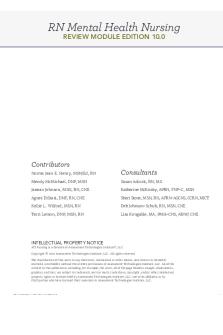
ebook for mental health nursing
- 219 Pages
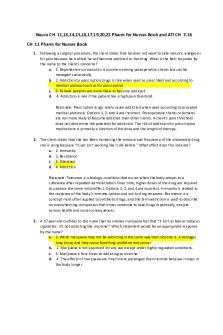
ATI TEST - mental health nursing
- 38 Pages
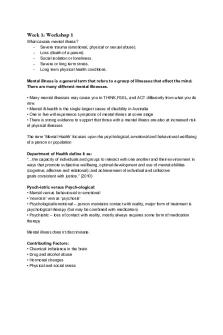
Nursing and Mental Health 1 Notes
- 62 Pages

Mental Health
- 44 Pages
Popular Institutions
- Tinajero National High School - Annex
- Politeknik Caltex Riau
- Yokohama City University
- SGT University
- University of Al-Qadisiyah
- Divine Word College of Vigan
- Techniek College Rotterdam
- Universidade de Santiago
- Universiti Teknologi MARA Cawangan Johor Kampus Pasir Gudang
- Poltekkes Kemenkes Yogyakarta
- Baguio City National High School
- Colegio san marcos
- preparatoria uno
- Centro de Bachillerato Tecnológico Industrial y de Servicios No. 107
- Dalian Maritime University
- Quang Trung Secondary School
- Colegio Tecnológico en Informática
- Corporación Regional de Educación Superior
- Grupo CEDVA
- Dar Al Uloom University
- Centro de Estudios Preuniversitarios de la Universidad Nacional de Ingeniería
- 上智大学
- Aakash International School, Nuna Majara
- San Felipe Neri Catholic School
- Kang Chiao International School - New Taipei City
- Misamis Occidental National High School
- Institución Educativa Escuela Normal Juan Ladrilleros
- Kolehiyo ng Pantukan
- Batanes State College
- Instituto Continental
- Sekolah Menengah Kejuruan Kesehatan Kaltara (Tarakan)
- Colegio de La Inmaculada Concepcion - Cebu
